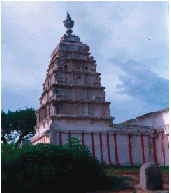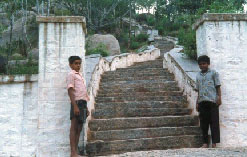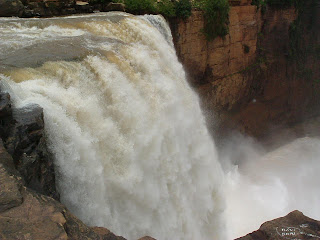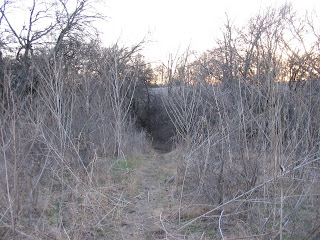Remembering Mahimapura One of my favourite places around Bangalore is Mahimapura, it is also the first place I visited alone on my bike. A quaint village with a small wooded hill one one side, this is one place I have never gotten bored visiting repeatedly. Friends whom I advised to visit the place also came back with similar experiences and loved the locale. I had written couple of articles about the place in Deccan Herald. The Garuda Ranganathaswamy temple in this village is actually the jewel in its crown. While the name may not be familiar, the locale is, at least for film buffs.
One of my favourite places around Bangalore is Mahimapura, it is also the first place I visited alone on my bike. A quaint village with a small wooded hill one one side, this is one place I have never gotten bored visiting repeatedly. Friends whom I advised to visit the place also came back with similar experiences and loved the locale. I had written couple of articles about the place in Deccan Herald. The Garuda Ranganathaswamy temple in this village is actually the jewel in its crown. While the name may not be familiar, the locale is, at least for film buffs.
Mahimapura is an inconspicuous village located off Bangalore-Pune highway. Modern development may have eluded this place, yet riches of nature, culture and tradition are found in abundance, causing excitement among a few who stumble on it. Garuda-Ranganathaswamy temple, perched on the quaint-wooded hillock in Mahimapura, is the jewel in the village's crown. The priest here says this Vijayanagara-style temple is the only one of its kind, where Garuda, the vehicle of Lord Vishnu, assumes equal importance as his master.
Mahimaranganathaswamy, the temple's presiding deity, is a mound of jaggery believed to have evolved naturally. The Vishnu idol worshiped now is said to be installed during the Vijayanagara era. The 12-foot Hanuman statue enshrined in the temple at the foot of the hillock is also a spectacular sight.
A steep climb 
A steep 300 ft climb over the hill's well-hewn steps would lead us to the temple. Statues of Garuda, Hanumantha and Ranganatha (installed) are open for worship. The small structure has a square Garbagraha (sanctum-sanctorum); the Vijayanagar-style cubical pillars have carvings of leaves. The tall Shikara of the sanctum-sanctorum, built of brick, is visible from a long distance. The statue of Ranganathaswamy appears similar to the Venkataramana, with the Shankha-Chakra and Abhaya-Varadha attributes.
However, the temple in its entirety stands as an unfortunate contrast to the beauty of the deity. Many of the attractive carvings on the walls and pillars are fading due to lack of maintenance. The elegance of sculptures is spoiled by the whitewashing, rather inexplicably done for a granite structure. Prayer in the temple is conducted only in the mornings, as it's believed that divine saints visit the shrine after sunset. Despite its obscurity, Mahimapura might appear faintly familiar to some people, especially to the avid followers of Kannada films. The predominantly rural locale and the calm surroundings have triggered the imaginations of directors, who have made this the backdrop for the song-dance sequences.
The Legend
The legend behind Mahimapura though, is devoid of any such romance. Its here Garuda was on penance to purge the sin he had committed by eating the corpse of a Rakshasi (ogress). Aditi, wife of sage Kashyapa, receives two eggs from the Sun god, who tells her that two children will be born when the eggs are hatched. Aditi waits for several years and finally loses her patience, as the eggs didn't hatch. She breaks open one of them and a baby born from it without arms and legs curses her to lead a life of slavery and banishment. Afraid, Aditi prays to the Sun god, who assures her that the child born from the second egg would rescue her.
Years later, Garuda emerges from the egg and demands food from Aditi, who directs him to Sage Kashyapa. Hungry and impatient, Garuda interrupts the sage's penance and repeats his demand. The angry sage asks him to eat the corpse of the ogress. Doing so, Garuda realises his sin and seeks the sage's forgiveness. Kashyapa asks him to worship Sri Ranganathaswamy at Mahimapura to atone for his sins. After long years of penance, Lord Ranganatha appears before Garuda as Nirakari (the mound of jaggery).
The annual Jatra on the Maha Poornima day, which kicks off a fortnight of festivities, is an important occasion for the temple. The festival is accompanied by cattle fair. Rathutsava or car festival, which lures devotees from several villages, is also a major celebration at the temple. These apart, festivals like Janmashtami, Dasara (Navarathri) and Narasimha Jayanthi are also celebrated here.
Getting there.
Mahimapura is found 45 kms from Bangalore on NH 4 (B’lore-Tumkur road). At this point, a board with the village's name points left, towards a small diversion. Driving a kilometre and a half into the road would lead to the foot of the hill. The KSRTC plies three busses to Mahimapura in a day. It's also possible to reach the village by local transportation from Nelamangala.
Saturday, January 05, 2008
Adding features to the blog
I have been looking through various websites and freeware providers to get new and innovative features for my blog. It is sometimes frustrating to go through various features and find that it doesn't work like you expect it to. But then what is life if everything were so easy? The same logic works in other aspects of the online computer thingy....
More than a decade ago when I first started learning computers on old 386 machines, these technology gadgets seemed as if they were capable of everything... I still remember those days (I don't know whether I should call them 'good ole days') when carrying a 5 and quarter inch floppy disc made us feel cool. Then came the CD era when a shiny gold CD was considered more valuable than the valuable metal itself. Then came the internet, like a bolt out of the blue and everyone was talking about free e-mails, Hotmail, Yahoo, Rocketmail, AltaVista and several names.
But as I learnt more and worked extensively on computers I slowly became aware of the inherent drawbacks and frustrations one has to face while trying to get tasks accomplished. Sudden system crashes, especially when you are working on the important project and not saved all the changes. Codes which seem perfectly fine when you debug but don't work when installed on the webpage. Websites which look different in different computers ... oh not to mention in different browsers too...
Now I have learnt to optimise and make peace. Just yesterday I had one of the most frustrating experiences trying to set up an RSS feed on my blog. Even now though the feed seems to be working with 11 subscribers, I don't know what the feed url of my blog is.... maybe I will figure out some day in the future. Let us hope so...
Friday, January 04, 2008
Gokak Falls – Karnataka’s Niagara
One can hear the roar of the fall much before it actually comes into sight. Gokak falls is formed when the Ghataprabha river after flowing through the black soil plains enters the rocky belt of Gokak where the flow of the river is broken by a tableland about 180 ft above the neighbouring valley, forcing the river to take a giant leap over the sandstone cliff, into a horseshoe shaped gorge. The falling river makes a thundering noise.
This is one of the few falls which one can get to the top and look down into the gorge where the water is falling down into the dizzying depths. The closer one gets to the fall and the louder one hears the roar of the water falling down into the valley is deafening. The sound makes it difficult to even make simple conversation and one has to shout hoarse to be heard. A walk along the cliffs beside the jumping waters is a soothing experience and provides panoramic views of rugged cliffs and water. Being an open space there is always a cool breeze bringing with it a gentle spray of moisture from the waterfalls.
Soon after the discovery of the falls, the British established the Gokak Water Power and Manufacturing Company – a textile mill – with an investment of Rs.20 lakh. Later in 1907-08 the company installed an electric turbine to generate hydro-electricity. The town’s colonial past is resplendent in the mill’s elegant stone buildings. The mill and the power plant are operational even today and the main activity of the former is conversion of Cotton into yarn.
Another important historical landmark here is the 210-metre long hanging wooden bridge built across the river built in 1907 to enable workers from nearby villages to cross the river and arrive at work. A walk on this century old creaking bridge – on which only 30 people are allowed at a time – is a thrilling experience. One can view the breathtaking vista of the waterfalls directly below as one walks across the bridge.
Getting there
Road. Gokak Falls is a mere six km from Gokak town and 71 km from Belgaum. Every 15 minutes a bus departs from Belgaum’s Khade Bazaar bus terminus to Gokak.
Rail. Ghataprabha railway station about 3 km from Gokak town is the nearest railhead. The Gokak falls is about 7 km from the railway station.
Air. Belgaum has a civilian airport at Sambra. Deccan Aviation operates regular flights from all major cities across the country.
More Pictures of the Falls


Al Ain - Garden City of Gulf
I visited UAE towards the end of 2004 and had written about the country in various publications. Just thought I'd repost one of them on my blog too. Enjoy reading. Al Ain sited close to the UAE-Oman border about 135 km from Dubai is attracting a large and growing number of leisure tourists who wish to take a break after a hectic shopping spree. Al Ain offers a plethora of rest and recreation opportunities, historical monuments, sports facilities and lots and lots of greenery. Naturally endowed with several large oasis’ Al Ain (pop. 500,000) is a green low-rise city sited in the shade of the Jebel Hafit mountains. Surrounded by awesome red sand dunes and the rugged craggy mountains, Al Ain is linked by excellent roads to Abu Dhabi, Dubai and Sharjah.
Al Ain sited close to the UAE-Oman border about 135 km from Dubai is attracting a large and growing number of leisure tourists who wish to take a break after a hectic shopping spree. Al Ain offers a plethora of rest and recreation opportunities, historical monuments, sports facilities and lots and lots of greenery. Naturally endowed with several large oasis’ Al Ain (pop. 500,000) is a green low-rise city sited in the shade of the Jebel Hafit mountains. Surrounded by awesome red sand dunes and the rugged craggy mountains, Al Ain is linked by excellent roads to Abu Dhabi, Dubai and Sharjah. Blessed with generous groundwater resources and self-renewing aquifers, Al Ain is one of the most fertile agricultural areas of the UAE, often described as the ‘garden city of the Gulf’. Indeed ‘Al Ain’ in Arabic means ‘spring’ and the region with its ancient but efficient non-mechanised falaj irrigation system boasts sprawling date and fruit plantations.
Blessed with generous groundwater resources and self-renewing aquifers, Al Ain is one of the most fertile agricultural areas of the UAE, often described as the ‘garden city of the Gulf’. Indeed ‘Al Ain’ in Arabic means ‘spring’ and the region with its ancient but efficient non-mechanised falaj irrigation system boasts sprawling date and fruit plantations.
Attractions in Al Ain The most popular tourist attraction here is the Al Ain Oasis. Sited in the epicentre of a cool date plantation and divided into numerous well-maintained date farms, the oasis is thronged by tourists who walk in quiet shades in lush greenery.
The most popular tourist attraction here is the Al Ain Oasis. Sited in the epicentre of a cool date plantation and divided into numerous well-maintained date farms, the oasis is thronged by tourists who walk in quiet shades in lush greenery.
Another equally popular locale in the city is the Al Ain Zoo and Aquarium, the largest in the Middle East. Spread over 400 hectares, the zoo is home to a wide variety of animal and marine species including elephants, tigers, bears and other animals peculiar to the desert. Although Al Ain boasts over 42 forts, the best examples of Arab fort architecture are the Jahili Fort — a large restored fort structure with distinctive corner turrets; Mujairib Fort comprising a main and smaller fort, a 50 ft tall watchtower, surrounded by a park and children’s playground; Hili Fort with its ornate entrance and sprawling courtyard, Al Rumeilah famous for its sandstone architecture and the Murabba, and Mazyad forts.
Although Al Ain boasts over 42 forts, the best examples of Arab fort architecture are the Jahili Fort — a large restored fort structure with distinctive corner turrets; Mujairib Fort comprising a main and smaller fort, a 50 ft tall watchtower, surrounded by a park and children’s playground; Hili Fort with its ornate entrance and sprawling courtyard, Al Rumeilah famous for its sandstone architecture and the Murabba, and Mazyad forts.
Also visit the Al Ain Museum known for its excellent collection of archaeological and ethnographic exhibits, antiquated gold pendants and an impressive coin collection apart from an array of gifts received by UAE’s president from visiting statesmen and royalty.
Leisure sports activities. Most visitors from the subcontinent dazzled, by the malls and shopping arcades of Dubai and Sharjah don’t know it, but the UAE also offers exceptionally well-developed desert and water sports opportunities. For the sports-minded and adventurous, there are several options such as camel safaris, desert camping, sand and grass golf, dune bashing, etc. Popular indigenous spectator sports include Camel racing and Dog racing.
Most visitors from the subcontinent dazzled, by the malls and shopping arcades of Dubai and Sharjah don’t know it, but the UAE also offers exceptionally well-developed desert and water sports opportunities. For the sports-minded and adventurous, there are several options such as camel safaris, desert camping, sand and grass golf, dune bashing, etc. Popular indigenous spectator sports include Camel racing and Dog racing.
Al Ain – Fact file Best time to visit. October-March is the best time. April-July is the hottest period and could prove fatal to those who can’t bear the sun’s heat.
Getting there.Air. The nearest international airport is Dubai (135 km), which is well connected with frequent flights from Hyderabad, Chennai, Mumbai, Bangalore and Cochin.
Accommodation and nightlife.As a well-developed leisure destination, Al Ain boasts three 5-star resort hotels — The Hilton, The Intercontinental and Rotana hotels, all set in expansive and meticulously landscaped environments. Al Ain also has a vibrant nightlife in its restaurants, bars, discotheques and night clubs. Top-end (Dhs.500-1,000): Intercontinental Palm Oasis Resort, Hilton International, Al Ain Rotana Hotel. Mid-range and Budget (Dhs.200-500): Mercure Grand Jebel Hafeet, Green Desert Hotel.Note: 1 UAE DH = Rs.13
Trying to install a feed
It is really frustrating. For the past 3 hours, I have been working and trying to put in place a proper RSS feed to my blog. It is another matter that, my blog may not attract even a single subscriber, but still I want to install this to learn how this damn thing works.
I get strange messages like "Parse Error", "url wrong", mistaken feed and what more... I wonder how techies manage to work around all the bugs and still write so much code for softwares... they must have loads of brains or loads of patience... unfortunately I don't have former and I am running out of the latter. But my perisistence is what is keeping me glued to this so I think I will work more and figure it out finally.
If any of you know anything do send me a mail.
Thursday, January 03, 2008
New Year - Old Routine
The new year is already 3 days old and it has been boring as ever. On new years eve we went out for dinner and visited a desi night club... and believe me this is one place which is definitely not Texas Size... the cramped place was crawling with people... all in various states of drunken stupor dancing away to glory... trying to usher the new year....
Feeling claustrophobic and suffocated by the wafting cigarette smoke we beat a hasty retreat. I was shocked to see a long line of people waiting in the biting cold to get into the night club. "These guys are crazy" I thought... wanting to get into that cramped, suffocating, airless space.. wonder what they were expecting to do there...
Anyway since that day I have been hanging around at home doing nothing much but reading books. I finished the book How Walmart is Destroying America and the World in which veteran journalist Bill Quinn explains the various negative impacts of the largest retailer in the world. How Walmart has virtually closed down most of the independent grocery stores and drugstores? How Walmart is a greedy company with no sentiment? How Walmart exploits its employees (associates) by paying measly wages and no health and other benefits? and other important questions are answered in this book. The author explains that for every 100 jobs created by Walmart, 150 people lose their livelihoods... not just jobs but they lose livelihood... the sole source of their living.
Reading this book it is scary to think what might happen to India when this retail giant enters and conquers the country. Already there are more than 800 million who eke out a living with less than $2 daily... there might be more added to that number. That is so much for bad news. Let me finish here before I get too cynical....
Tuesday, January 01, 2008
Happy New Year 2008
A year has gone by and I don't know what I have been doing.... first quarter was spent on the tour... second quarter getting back into groove of work and professional life, third and fourth quarter just flew by...
Now a new year is staring at me in the face... I was browsing the net for various ways in which one can send wishes online and found these different ways... check it out I am sure you will find it interesting. I visited this online greetings site... New-Year.in... year an Indian domain name... and found all these great graphics... check it out.. it may be too late for this year.. but if you remember or book mark this site you can use it next year. 




Monday, December 31, 2007
Hiking in Arbor Hills Yesterday we went to Arbor Hills Nature Preserve for a walk. A welcome change after being cooped up indoors through the weekend. The Arbor Hills Nature Preserve is located close to our home... maybe about 2-3 miles. It is a 200-acre open area with concrete walking/ hiking trails and off road mountain bike and hiking trails. The Preserve offers a close-to-nature experience with an abundance of serenity and an escape from the chaos of urban sprawl. Arbor hills hosts several species of plants, trees and animals and with several brooks and creeks flowing through the preserve it is an ideal place to spend a quiet afternoon amidst nature. Speaking about fauna Arbor Hills supports a variety of rats, birds, bats, Rabbits and fish in the creeks. A pond at one extreme of the preserve serves to stock up fish.
Yesterday we went to Arbor Hills Nature Preserve for a walk. A welcome change after being cooped up indoors through the weekend. The Arbor Hills Nature Preserve is located close to our home... maybe about 2-3 miles. It is a 200-acre open area with concrete walking/ hiking trails and off road mountain bike and hiking trails. The Preserve offers a close-to-nature experience with an abundance of serenity and an escape from the chaos of urban sprawl. Arbor hills hosts several species of plants, trees and animals and with several brooks and creeks flowing through the preserve it is an ideal place to spend a quiet afternoon amidst nature. Speaking about fauna Arbor Hills supports a variety of rats, birds, bats, Rabbits and fish in the creeks. A pond at one extreme of the preserve serves to stock up fish.
There are over 2 miles of concrete trails, unpaved hiking paths and a bike trail. One can spend the whole day hiking, walking and visiting the various spots of the nature preserve. This is just not for hikers and adventurers, for families with children there is a Playground, Paved recreational trail (approx. 4.4 miles), Natural unpaved trails for pedestrians, designated off-road cycling trail (approx. 2 miles), a natural biofilter for cleaning surface run-off from the parking lot before it reenters the ground water tables and an observation tower which offers some fantstic sunset views. Yesterday was my third visit to the Nature Preserve and this time I had remembered to carry the camera to take some pictures. And yesterday we explored the most in the park, we went to almost every nook and corner of the preserve crossing creeks, walking over rickety wooden bridges, along off road trails, along the railway tracks which forms one border of the preserve, along the fish-filled creek etc. A truly invigorating experiece.
Yesterday was my third visit to the Nature Preserve and this time I had remembered to carry the camera to take some pictures. And yesterday we explored the most in the park, we went to almost every nook and corner of the preserve crossing creeks, walking over rickety wooden bridges, along off road trails, along the railway tracks which forms one border of the preserve, along the fish-filled creek etc. A truly invigorating experiece.
One peculiarity I noticed in the park is the totally brown and leafless trees contiguous to lush green ones. The former has shed leaves due to fall and the latter continues to be green and unaffected by the fall. There are trees which don't have any leaves but are full of colourful fruits, red, yellow, brown, green etc, so the tree in effect looks red and attractive. Felt good watching these and capturing these unique sights in the camera.
Arbor Hills Nature Preserve Pictures





Click here for a map of Arbor Hills














